A Reunion In Danville- June 1950
In 1950, the Chief, now the alumni secretary at Centre, invited all former letter winners to come to a reunion on the campus. There was to be the annual Centre Carnival, the dedication of a new addition to the Boyle-Humphrey Gymnasium, and a special function to honor the old Colonel veterans from the early 1920's teams who were coming back to the scene of so many memories from some 3 decades before.
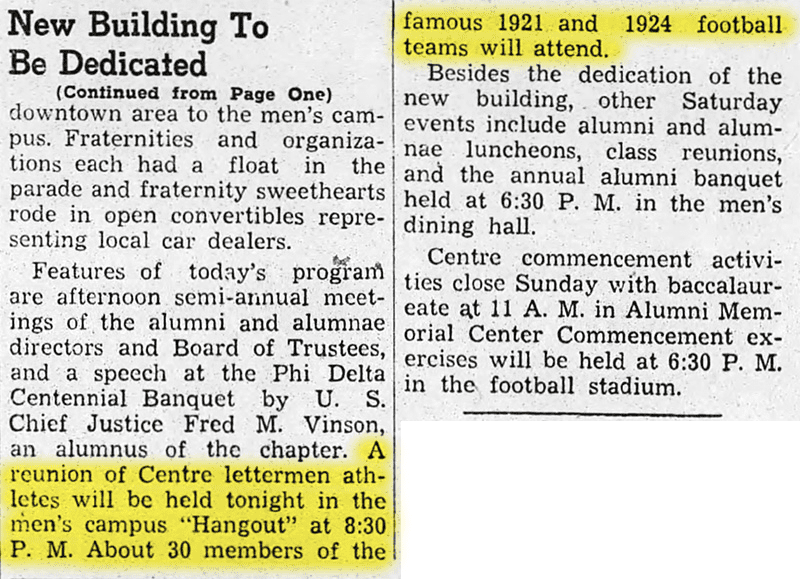
Red Robertson's brother, Howard, was at the "reunion of Centre lettermen athletes" at the 1950 event at the "Hangout," which was a white, clapboard army-type building that served as the college’s student center from 1947 to 1961. It was located behind Old Main.

The Hangout, the site of the 1950 reunion organized by the Chief
The featured speaker at the Phi Delta Theta banquet June 10 was Fred M. Vinson, Centre Class of 1909, Chief Justice of the United States Supreme Court.
There were 32 players from Centre's "Golden Years" attending the weekend's events. Of the 28 Colonels who were at Soldiers Field on October 29, 1921 for the Harvard game, 16 were in Danville at the reunion.
Those who were at the 6-0 win are designated with a (*).
Army Armstrong (*) Clarence Jones Walter Skidmore
George Jones (*) Terry Snowday (*) Hump Tanner (*)
Alexander Bush Ed Kubale (*) Bracken Tate
George Chinn (*) Hennie Lemon (*) Case Thomasson (*)
Herb Covington (*) Herman Lowenthal Bob Waddell
Ben Cregor (*) Howard Lynch Red Weaver
Ed Diddle George McClure Lefty Whitnell
Dick Gibson (*) Bo McMillin (*) Reginald Wilson
Minos Gordy (*) Joe Murphy (*) Additionally, those there at the reunion included:
Carl Hilker Jim Priest John McGee- team manager
Hope Hudgins (*) Elmer Rabenstein Chief Myers- athletic director/assistant coach
Bill James (*) Marshall Shearer "Swede" Anderson- team trainer
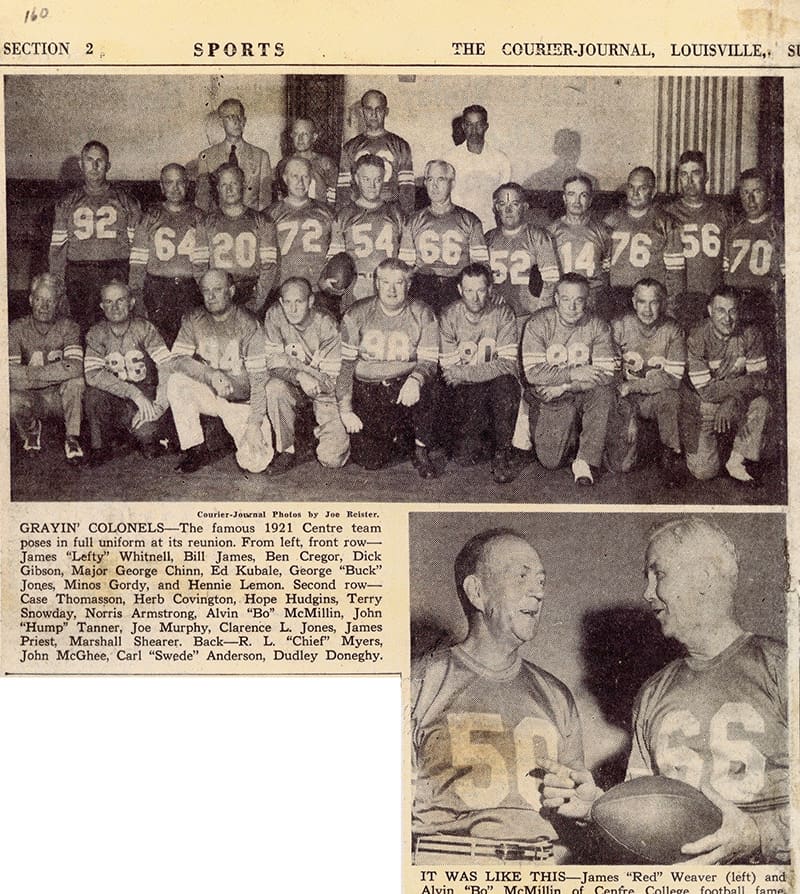
The attendees ( above ) at the 1950 Colonels' reunion, most of whom who had been at the 1921 Harvard game, and two Walter Camp All-Americans ( lower ) from 1919, Red Weaver and Bo McMillin
Attendees included Johnny McGee, the student manager and "Swede" Anderson, the head trainer during the "Wonder Team" era, who became head coach in 1946-50.
The other trainer and "rubber," Dudley Doneghy, was also there. Dudley had become associated with the team as a 24 year old in 1919, the year that Centre was undefeated and claimed the National Championship. He ended his career in 1955, a year that the Colonels were also undefeated. It was Dudley on whom Uncle Charlie and all of the subsequent coaches relied so heavily. He was a constant over the years. Coaches and players came and went, but Dudley was always there. When he died suddenly on November 28, 1962, Army spoke on behalf of the Centre Board of Trustees and said, "Centre lost a devoted friend. He was always popular with the Centre athletes and other students and was a wonderful person."
Team captains who attended were:
1917 Bracken Tate
1919-20 Bo McMillin
1921 Army Armstrong
1923 Ed Kubale
1924 Herb Covington
Red Roberts, captain of 1922, had tragically been killed in a hotel fire in Middlesboro, Kentucky, June 27, 1945.
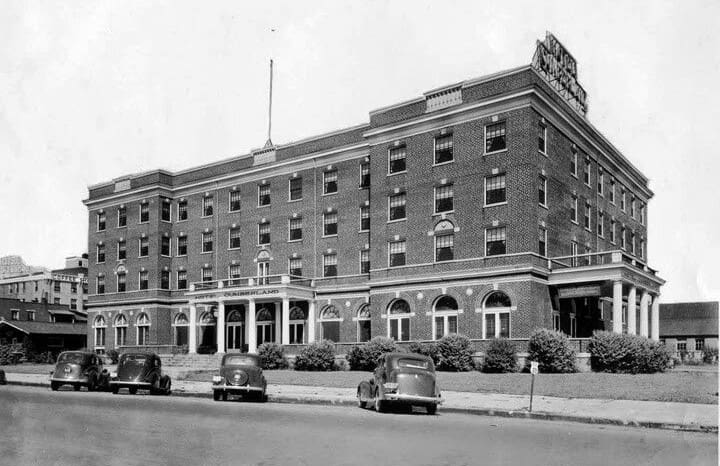
Hotel Cumberland, built in 1922 to replace the original hotel which was destroyed in a fire in 1921. Ironically, it was the site of another fire in 1945 which ended the life of Centre's All-American, Red Roberts.
Red Roberts had been the manager of the Hotel Cumberland in Middlesboro and fell asleep on a couch in his suite after a visitor had left. His wife was in the adjacent bedroom, sleeping. Apparently, an electrical fire had broken out and Red was badly burned and died later after being taken to the hospital. The fire was basically contained in Red's suite. At his funeral in Somerset, Kentucky, pallbearers were Bo McMillin, Ed Kubale, Army Armstrong, Ben Cregor, Chief Myers, and Red's football coach at Somerset High, Paul Dexheimer.
Walter Skidmore was the captain of the 1925 team and was at the reunion. He was also a valuable team member during 1923-24, having also lettered during those years, and his service as captain of the '25 team deserves mention.
Sending his regrets was Matty Bell, captain of the 1918 team, who had significant success as the head coach at several colleges and was the athletic director at SMU at the time. His 1935 top-ranked Mustangs were 12-0 before losing to Stanford in the Rose Bowl, 7-0.
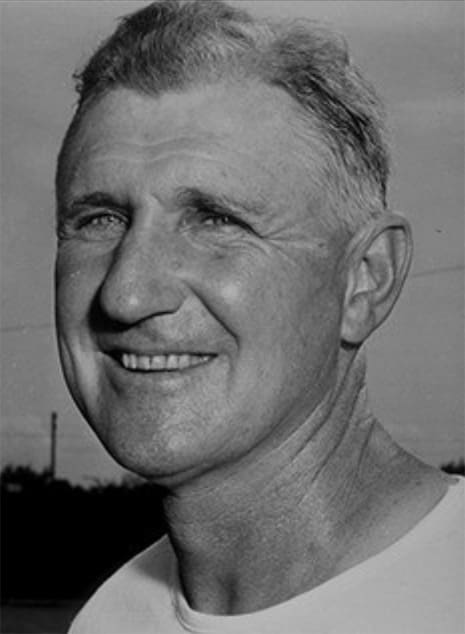
Matty Bell, one of the Chief's Fort Worth North Side players who was at Centre and played on the 1916-19 teams. Bell had an overall record 153-88-17 during a coaching career which began in 1920 and ended in 1949, having missed the 1942-44 seasons due to serving in the Navy.
Also sending a letter and having to decline the invitation was Bob Mathias, who was on the 1916 and 1917 teams and now president of the Chicago National Bank.
It was Bob Mathias who had blurted out, "Damnit Unc! Let me pray!" to Uncle Charlie before the 1917 game with UK which led to the Centre College Colonels becoming "The Praying Colonels."
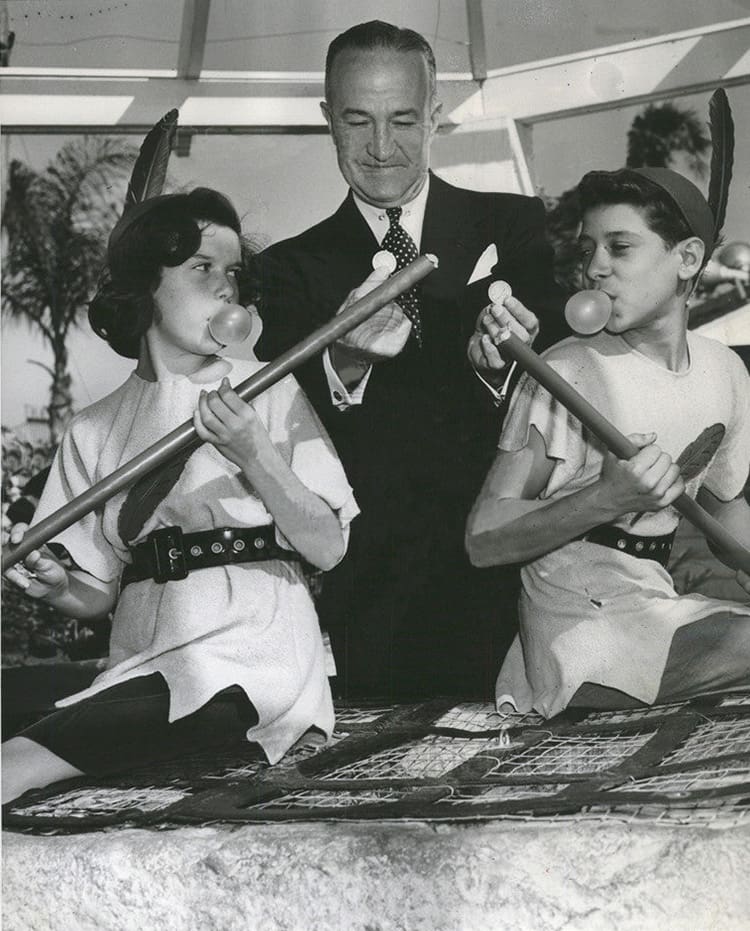
Robert D. "Bob" Mathias at a fund raiser for a charity in 1949. Mathias had been president of Old National Bank in Evansville, Indiana from 1940 before assuming the top position at Chicago National in July, 1948.
Tom Bartlett, another long-time banker who had been the vice-president and cashier of the National Deposit Bank in Owensboro, Kentucky, and later, in 1951, became the president of the Owensboro National Bank, also regretted, as did Sully Montgomery, who was in a hot race for sheriff in Fort Worth and wrote that he wasn't able to break away.
Despite all of the accomplishments of the men in attendance who had been members of the Gold and White, the man commanding the most attention was presiding over the reunion at the "Hangout," Robert L. "Chief' Myers.
The Colonels stood and told story after story about how the Chief had influenced their lives. It was an evening devoted to pouring out their feelings of admiration, gratitude, and love for their mentor, a man they had always also considered their great friend. Over and over, they gave him credit for helping them in their later lives by instilling the "spirit of Old Centre, and the will to try just a little harder when the going was the hardest."
Bo told the story about when he was in Somerset and so homesick and lovesick that he was going to hop a freight and return to Fort Worth.
"Thad and Red hid my shoes and called the Chief who came down on a train from Danville and talked me into staying and getting my credits. I don't know what I would be doing today if Chief Myers hadn't talked some sense into me. I do know one thing. Everything I have ever done, and everything I have ever become, I owe to the Chief."
George Chinn related how influential the Chief had been in his life and also entertained the crowd with a story about how he had become a Marine rather than being in the Navy.
"The recruiter told me was going to run the 'match test.' He was going to put a lighted match outside of my ear and if he saw light coming out of the other ear, I would be put in the Marines."
"They assigned me to the Marines!"
Many a tribute was also paid to Uncle Charlie who had died just the year before at age 71.
It was Uncle Charlie, a great teacher, who taught them to play "manly football," hard but clean, always representing Centre in a way which would earn the respect of their opponents. A copy of a tribute written the year before was enlarged and placed on an easel at the reunion.

Earl Ruby, long-time sports editor of the Louisville "Courier-Journal," wrote a moving tribute to "the man who was a dominating influence in American athletics." Ruby used "Uncle Charley" but it was always "Uncle Charlie" and the highway bearing his name is "Charlie Moran Highway."
The Chief very emotionally closed out the evening by praising each of "my boys."
"You have truly believed, and those beliefs allowed you to achieve your dreams. As I look out upon each of you, I know that your days at Old Centre molded your lives so that you were provided the knowledge and will to succeed, just as we had so much success during those years which are so near and dear in our memories, but now so far removed."
The Chief resigned from Centre in the fall of 1950 and took the position of director of publicity at Trinity University in San Antonio, Texas. Before he left, he was given a certification of appreciation from many of the young men who had been so greatly influenced by him. It was dated November 24, 1950 and is now hanging on the wall of his granddaughter, Karen Lee Myers Crosby in Colorado Springs, Colorado.

Amongst all of the players is Red Robertson, the author's father, halfway down the right hand column. The team's greatest fan made the list of the greatest of those who had been there during the Chief's years on Centre's campus!
I didn't make the 1950 reunion and wished I had. But, I was really busy in my medical practice and simply couldn't free up the time. I would have loved to see all of the guys again and particularly hear Chief Myers speak. But my brother Howard, as a former letterman, was there at the reunion and told me how moving the Chief's comments were.
I kept up with the Chief after he returned to Centre as the Alumni Director in the 1940's until 1950.
He was great about sending out cards and I saved some of them.
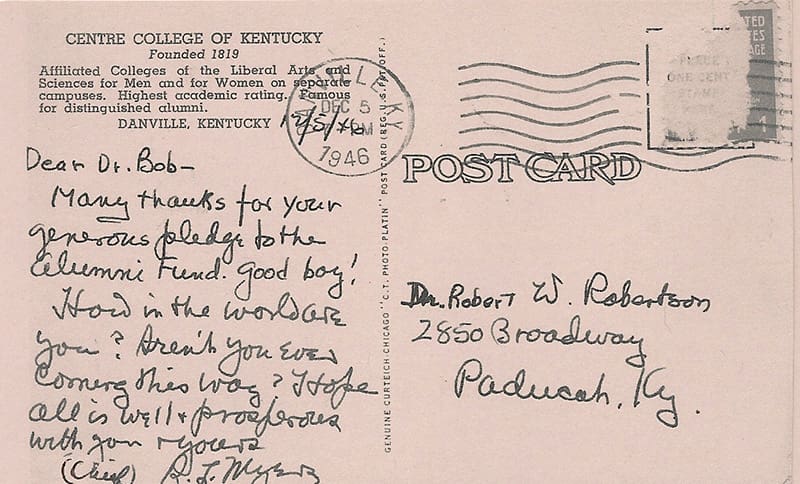
Card in 1946 to Red Robertson from Chief Myers
The last one I received was when he was in Texas in February of 1953. Hennie Lemon and I had heard that he was sick and was a little short of funds so we sent him money. Since he was in a sanatorium, we felt he must have tuberculosis.
Chief Myers, the man who started it all for Centre, the man who had the dream and literally made the Wonder Team possible, died at the home of his son, James Sevier "Jimmy" Myers, Centre '31, in Algonquin, Illinois, on May 5, 1953 at age 65.
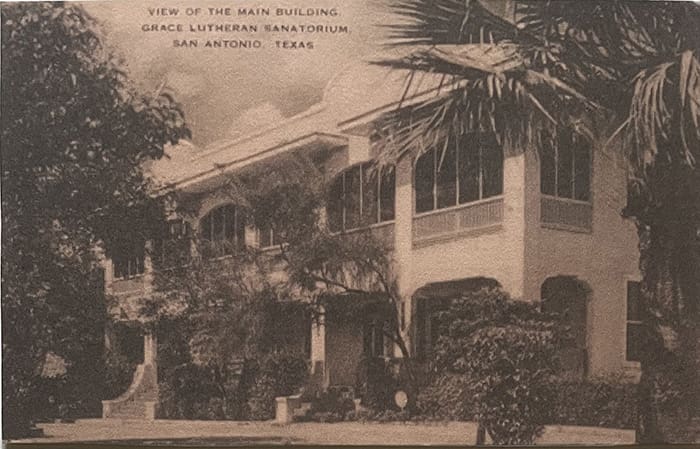
Grace Lutheran Sanatorium, San Antonia, Texas.
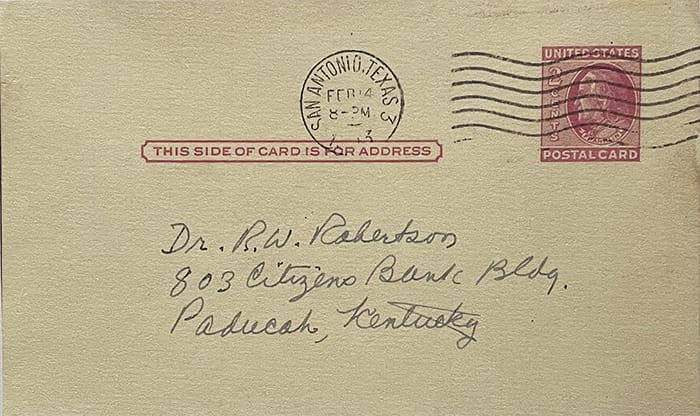
February 14, 1953
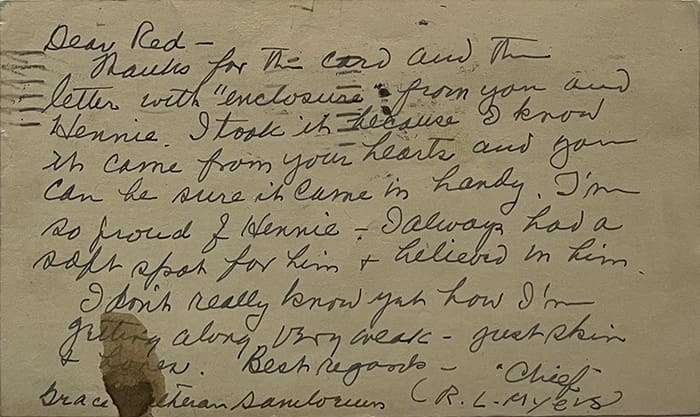
It was "Chief" back in 1912 when Robert L. Myers was given that nickname by his players at Fort Worth's North Side High, and it was still "Chief" some 4 decades later.
